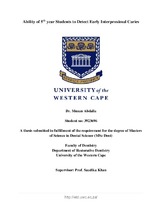Ability of 5th year Students to Detect Early Interproximal Caries
Abstract
Objective: The objectives of this study were to evaluate the diagnostic capability of 5th year
students using digital imaging, conventional bitewing radiographs (BW), printed film on paper
and to compare the results with the observers’ experience level to detect early interproximal caries
lesions on radiographs. To map the literature in regards to different diagnostic methods that
students use globally in dental clinics by conducting a scoping review.
Methods: A cross-sectional study was conducted with senior dental students (Reg No: BM
19/9/8). Three digital radiographs were shown individually to the students on a screen, 3 bitewing
radiographs and 3 printed films on paper were passed on individually to all students with a
questionnaire; with a viewing time of 2 mins per radiograph; thus 9 radiographs in total were
viewed. A control group consisting of specialists from both the Restorative and Radiology
Departments had finalized the answers prior to conducting the study regarding the
presence/absence of caries and its depth on all 3 different radiographic images. The answers
recorded by students were divided into 5 categories, R0: Intact surface, R1: Radiolucency in outer
half of enamel, R2: Radiolucency in inner half of enamel, R3: Radiolucency in outer half of dentin,
and R4: Radiolucency in inner half of dentin.
A protocol specific for the objectives of this study was developed according to the criteria for
a scoping reviews. Relevant databases (Pubmed, Scopus, Ebscohost, Science Direct, Wiley Online
Library and Cochrane Library) were searched to identify evidence which was restricted to the
English language for the period 2015–2021.
Results: Comparison using an Anova test on the 3 different diagnostic methods showed that the
type of method used affects the presence detection and size measuring accuracy, where the P-value
confirms a significant difference. The Prisma flow diagram showed a result of the most common
methods for diagnosing interproximal caries happen to be visual examination and bitewing
radiography.
Conclusions: Senior dental students have shown good accuracy in detecting the presence of
interproximal caries. Although the accuracy in detecting the size of carious lesions was poor.

